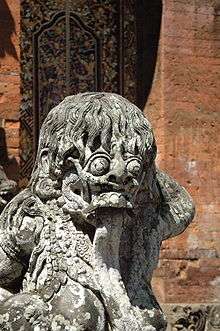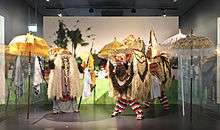Rangda
Rangda is the demon queen of the Leyaks in Bali, according to traditional Balinese mythology. Terrifying to behold, the child-eating Rangda leads an army of evil witches against the leader of the forces of good — Barong. The battle between Barong and Rangda is featured in a Barong dance which represents the eternal battle between good and evil.[1] Rangda is a term in old Javanese that means "widow".

Description
Rangda is important in Balinese culture, and performances depicting her struggles with Barong or with Airlangga are popular tourist attractions as well as tradition. She is depicted as a mostly nude old woman, with long and unkempt hair, pendulous breasts, and claws. Her face is traditionally a horrifying fanged and goggle-eyed mask, with a long, protruding tongue.
History
Bali is a Hindu island, and it is suggested that Rangda may also be closely associated with Durga.[2] She has also been identified with the Hindu but tribal mother warrior goddess, and Kali, the black mother goddess of destruction, transformation and protection in Sanskritised tribal Hinduism.
While Rangda is seen as fearsome and by many as the personification of evil, she is also nevertheless considered a protective force in certain parts of Bali, much like Kali is seen as a benevolent mother goddess of fertility and destruction in Northeastern India in Assam, Tripura. The colors associated with her — white, black and red — are identical with those associated with Kali. Her iconography is similar to that of both Kali and Chamunda, who are closely related.
Rangda was linked to the legend of Calon Arang and also the legend of divorced and exiled Javanese queen Mahendradatta. The name Rangda in old Javanese and Balinese language means "widow".
Calon Arang
Rangda is known as a Leyak queen, the incarnation of Calon Arang, the legendary witch that wreaked havoc in ancient Java during the reign of Airlangga in late 10th century. It is said that Calon Arang was a widow, who has mastered the art of black magic, who often damaged farmers' crops and caused disease to come. She had a daughter, named Ratna Manggali, who, though beautiful, could not get a husband because people were afraid of her mother. Because of the difficulties faced by her daughter, Calon Arang was angry and she intended to take revenge by kidnapping a young girl. She brought the girl to a temple of Death to be sacrificed to the goddess Durga. The next day, a great flood engulfed the village and many people died. Disease also appeared.
King Airlangga, who had heard of this matter, then asked for his advisor, Empu Bharada, to deal with this problem. Empu Bharada then sent his disciple, Empu Bahula, to be married to Ratna. Both were married with a huge feast that lasted seven days and seven nights, and the situation returned to normal. Calon Arang had a book that contained magic incantations. One day, this book was found by Empu Bahula, who turned it over to Empu Bharada. As soon as Calon Arang knew that the book had been stolen, she became angry and decided to fight Empu Bharada. Without the help of Durga, Calon Arang was defeated. Since she was defeated, the village was safe from the threat of Calon Arang's black magic.
Other interpretations claim that Rangda was actually derived from the historical 11th-century queen Mahendradatta or Gunapriyadharmapatni, a Javanese princess sister of Dharmawangsa of East Javanese Isyana Dynasty of late Medang Kingdom period. She was the queen consort of Balinese king Udayana and Airlangga's own mother. Mahendradatta is known for her devotion to the cult of Durga in Bali.
The story goes that Mahendradatta, the mother of Airlangga, was condemned and exiled by the king, Udayana, for allegedly practising witchcraft and black magic. After she became a widow, hurt and humiliated, she sought revenge upon her ex-husband's court and the whole of his kingdom. She summoned all the evil spirits in the jungle, the Leyaks and the demons that caused plague and death in the kingdom. She proceeded to take her revenge by killing off half the kingdom, which by then belonged to her and Dharmodayana's son Airlangga, with plague before being overcome by a holy man.[1]
Gallery
 Rangda in a Barong dance scene.
Rangda in a Barong dance scene. Statue of Rangda at a temple.
Statue of Rangda at a temple. Rangda's attendant in a Barong dance.
Rangda's attendant in a Barong dance. Barong dance performance with kris dancers and Rangda.
Barong dance performance with kris dancers and Rangda. Representation of Rangda in a Barong dance.
Representation of Rangda in a Barong dance. Rangda and Barong.
Rangda and Barong. Modern Rangda statue at Ngurah Rai International Airport, Bali.
Modern Rangda statue at Ngurah Rai International Airport, Bali.
See also
- Barong (mythology)
- Balinese dance
- Balinese art
- Balinese theater
- Folklore of Indonesia
- Hinduism in Indonesia
- Village Goddess
- Wewe Gombel
Notes
- indo.com (2001). "The Barong Dance of Bali". indo.com. Retrieved 2012-01-17.
- Brinkgreve, Francine (1997). "Offerings to Durga and Pretiwi in Bali". Asian Folklore Studies. 56 (2): 227–251. JSTOR 1178726.
Further reading
- Coldiron, Margaret (Fall 2005). "Lions, Witches, and Happy Old Men: Some Parallels between Balinese and Japanese Ritual Masks". Asian Theatre Journal. 22 (2): 227–248. doi:10.1353/atj.2005.0021. JSTOR 4137132.
External links
| Wikimedia Commons has media related to Rangda. |